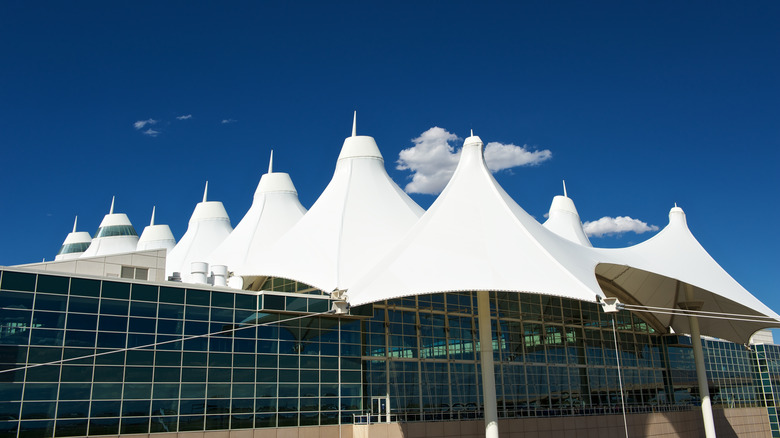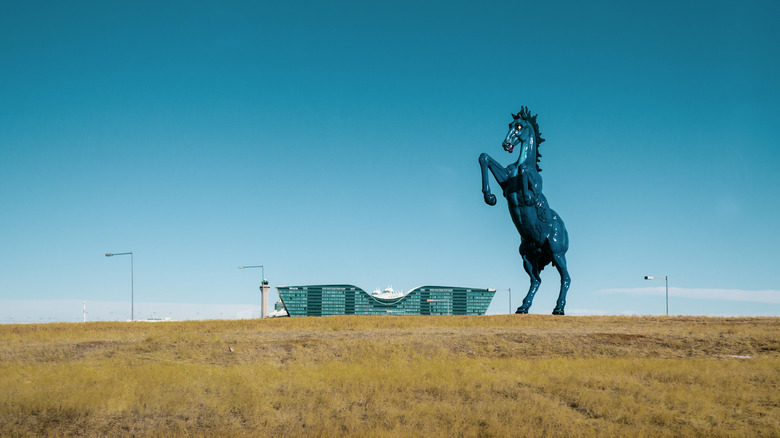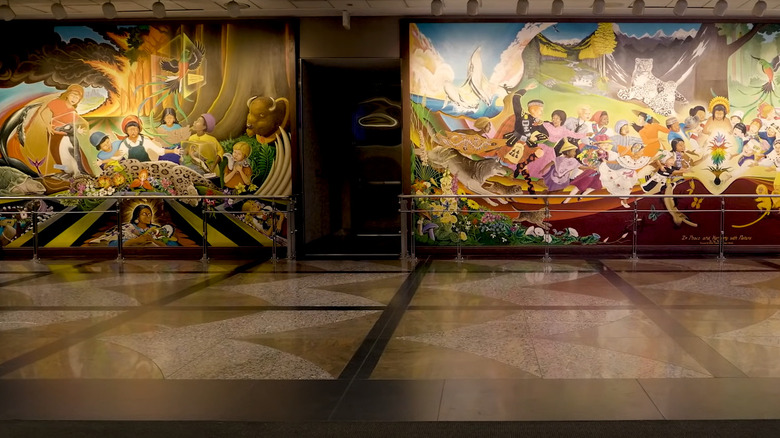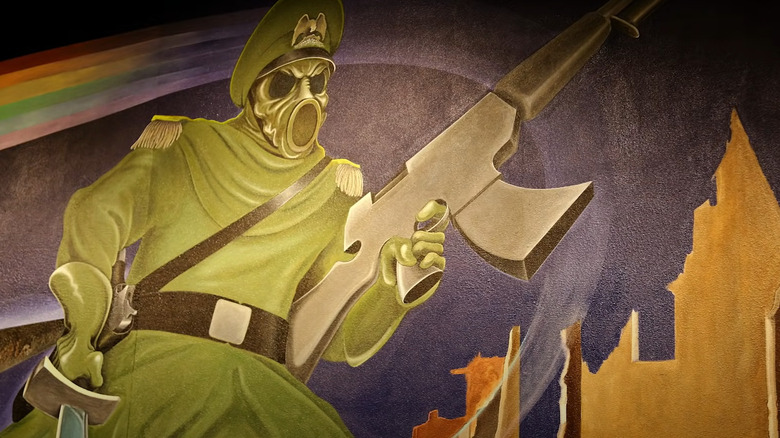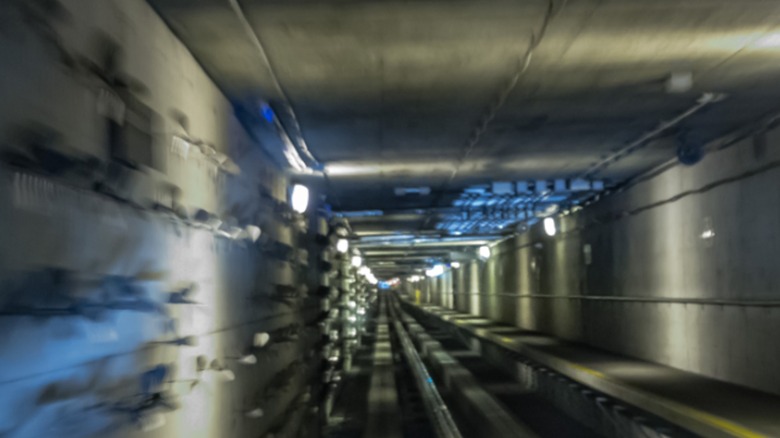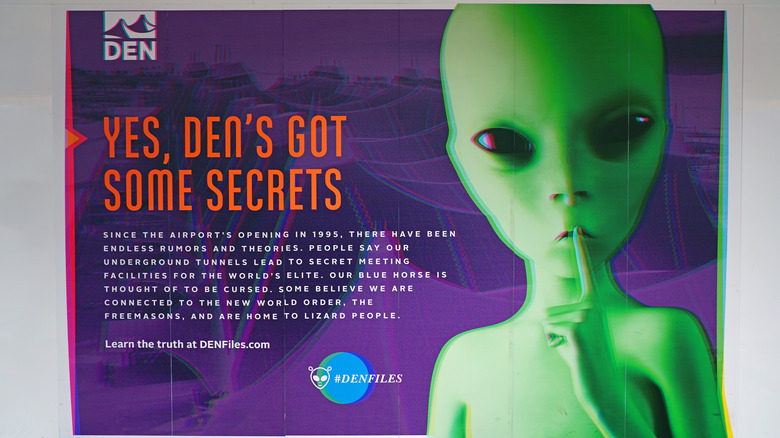The Denver Airport Conspiracy Theories Fully Explained
For most travelers, the airport is a mundane (if stressful) necessity. You go there to get somewhere, anywhere, else. Arrive early, get through security, maybe hit up a Hudson News, and then it's a lot of hurry-up-and-wait until your flight boards. But what if the airport were somehow more exciting, full of mystery — maybe even a bit of conspiracy? Sure would make a business trip seem a lot more thrilling.
Maybe that desire is what's behind the years of rumors and intrigue surrounding the Denver International Airport, which has seen its profile elevated by a particularly vocal group of online true believers in conspiracy. There are many who contend that the facility, built in 1995, harbors everything from demonic art and alien mapping coordinates to secret tunnels and malevolent gargoyles.
For its part, airport leadership playfully leans into the theories with its own media-friendly conspiracy explainer, that patiently debunks much of the conjecture (but still leaves room for fun). So while we can't endorse any of these theories, we sure can let you know what they are so the next time you fly into Denver, you can explore and come to your own conclusions.
Killer art
It seems only fitting to begin any discussion of the Denver International Airport's (DEN) conspiracies with the story of the allegedly cursed "Blue Mustang," a 32-foot tall, 9,000-pound sculpture of a horse that welcomes travelers by rearing up on its hind legs, flaring its nostrils, and emitting an eerie red glow from its eyes. Have a good flight!
While there's plenty of room for subjectivity in how art is interpreted, the lore surrounding this piece is actually rooted in some unsettling truth: it really did kill its maker, Luis Jiménez, by falling on him during its construction, earning itself the devilish nickname "Blucifer" in the process.
As the airport patiently notes, though, this happened in 2006 before the mustang ever bucked its way onto Peña Boulevard or trained its glowing eyes on weary travelers with its unknowable intentions. Despite years of setbacks, a ballooning budget, and a few lawsuits, family and friends completed the artwork in California and sent it to its new realm, er, home in Denver where it has stood guard ever since.
While some see the statue as lurid, tacky, or even evil, Stacey Stegman, DEN's senior vice president of communications, marketing and customer service, told Colorado Public Radio that the airport sees it differently. "We have this fierce blue mustang that we look at as kind of a protector of travelers, guarding this airport."
Hidden symbolism
Conspiracy theories or not, if you find yourself at DEN, you're in luck: It's one of the most public art-rich airports in the country. Much of that may be thanks to how the city of Denver prioritizes art. According to Denver Public Art, for each municipal capital improvement project that costs over $1 million (e.g., an airport), 1% is set aside for the creation of public art. With its dramatic Rocky Mountain backdrop, it makes sense that Denver has a thing for beauty. Still, where some see the sublime, others see the subversive.
Take the baggage claim, where two murals in the airport's Great Hall, each by the artist Leo Tanguma, depict scenes of nature and peace. If you were to simply glance at the vibrant murals, you'd likely not notice anything odd. Their energetic colors and massive scale are striking. But some see their themes as sinister.
"In Peace and Harmony with Nature" appears to be a scene depicting the contrast between environmental ruin and environmental healing, which you might not think would be controversial. But it's the details that fuel the speculation, as observers have noted the prominent positioning of the Quetzal bird, which some have associated with extinction. This certainly bolsters support for the fringe belief that DEN will serve as a sanctuary for those privileged few who survive a mass extinction event in the near future. For its part, DEN's conspiracy media primer graciously notes that they are, not, in fact, controlled by a "New World Order."
Celebrating peace — or destruction?
If you find yourself thinking that surely a mural depicting children longing to live in peace couldn't be misinterpreted, you probably don't often find yourself in some of the scarier corners of the internet. While the airport describes the second of these Tanguma murals (which is temporarily in storage and is not on display) as a plea for peace, many have nevertheless interpreted "Children of the World Dream of Peace" quite differently. In fairness, it does depict lots of children happily rejoicing over the death of a soldier, so you can see why this one might go a few unexpected places, artistically.
For her part, the artist's daughter and collaborator, Leticia Darlina Tanguma, told the Colorado Sun that such interpretations obscure the real artistic intent. "I think rumors like the airport conspiracies and the mural conspiracies, they really seek to destroy the human connection, the human spirit. But I want to create artwork that will bring us together," she explained.
Insidious infrastructure
Before you get the impression that all the conspiracy theories about DEN relate to its art, you should know that would be a dangerous underestimation of the true scope of the armchair conspiracy theorists' vision.
According to DEN's own press kit, some believe that tunnels exist below the airport for much more nefarious reasons than serving the infrastructure needs of a massive transportation hub. Instead, speculation centers on the idea that these tunnels extend for more than 120 miles — from the airport all the way to the North American Aerospace Defense Command's (NORAD) Cheyenne Mountain Complex, presumably to keep the nation's elite safe.
Instead, as The New York Times found when a reporter took a tour with one of DEN's communications staff in 2023, these tunnels are a whole lot shorter, and mainly used for moving your luggage from one side of the airport to another. At least we know DEN thinks of the customer as elite.
A real conspiracy grab bag
Allegedly menacing art and nefarious architecture aside, these theories barely scratch the surface of speculation about the airport, so what's a curious traveler to do? Well, if you've got time, we recommend a speed run through the airport on your next visit, to really take in all the kookiness. Don't forget to snap a pic of the Great Halls' sinister inscriptions of deadly toxins designed to wipe out humanity, "Au Ag." Just kidding, DEN says those just stand for the atomic abbreviations of gold and silver as an homage to the state's mining history.
So how about the one that says the coordinates given to humans by aliens in "Close Encounters of The Third Kind" (W104' 44' 30' N40' 36' 10', for those who are curious) actually direct you to the airport? Well, that would indeed be pretty creepy if it were true. Instead, those will land you almost an hour northwest of DEN, which would be scary ... a scary-expensive Uber ride.
And, far from discouraging this behavior, DEN seems to delight in it. While some have argued its baggage claim gargoyles by artist Terry Allen bode evil intent, the airport reminds its visitors that gargoyles have instead long been seen as a talisman of protection in art. And to further defang the scary interpretation, one gargoyle named Greg, actually talks to visitors, welcoming them, as he puts it in a DEN-made video, to "Illuminati Headquarters ... _I- I mean the Denver International Airport."
